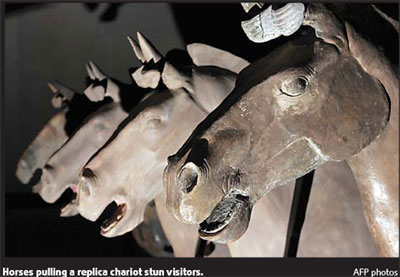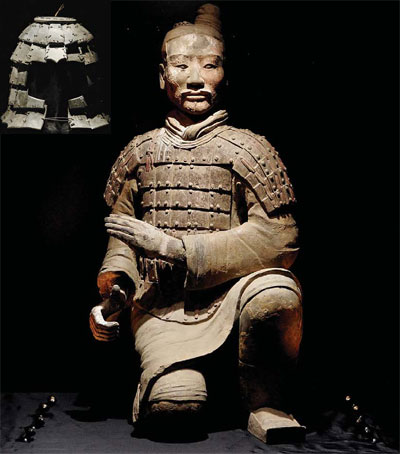Derick McGroarty stared in astonishment at a 2,200-year-old, life-size standing terracotta soldier. "It's fabulous to see them face to face," says McGroarty at the The First Emperor: China's Terracotta Army exhibition that opened at the British Museum in London, yesterday.
"I just can't imagine the sight of thousands of them standing together at their home," says McGroarty, a freelance travel writer from Southampton, England. He finds the different expressions on the soldiers' faces overwhelming and says it is a pity he did not have enough time to go to Xi'an, the place where the terracotta warriors were discovered, when he visited China 15 years ago.
In the dim light of the temporarily converted Reading Room in the heart of the museum, a dozen terracotta soldiers with their chariots and horses stand quietly, while on a huge screen a documentary describes how one of the world's most amazing treasures was discovered. On display are 120 objects including bronze bells, vessels and other artifacts, 12 life-size complete warrior figures and eight complete figures of new finds - acrobats, musicians and bureaucrats.
This is the first time the famous Reading Room is being used as a temporary exhibition space, covering 1,150 square meters.
"Don't you think it's perfect to have the exhibition in the dome-style Reading Room," asks McGroarty's wife Mildred. "It very much matches the mood."
A stone helmet (above) and a terracotta army figure.
The terracotta exhibition is being hailed by the media in London as the British Museum's most important exhibition in 30 years. A report in The Independent newspaper says the display will electrify the British public as surely as Tutankhamen's golden mask did in the 1970s.
Over the past two months, big posters scattered around the city have been creating an air of anticipation of the terracotta army's arrival from China. The souvenir shops of the museum are filled with mini statues of terracotta soldiers, postcards, albums and other related items.
Nearly 138,000 tickets have been sold for the seven-month exhibition, according to museum sources.
"It's not surprising," says Jane Portal, exhibition curator. "China has become such an important country to the rest of the world. It is growing so quickly, and of course it will be holding the Olympics next year. People are interested in it.
"The China we see today can trace its roots back to around 220 BC, and the reign of the First Emperor."
The exhibition features the largest group of important objects related to the First Emperor ever to be loaned abroad by the Museum of the Terracotta Army and the Cultural Relics Bureau of Shaanxi Province in Xi'an, capital of Northwest China's Shaanxi Province. "It is the first time that finds at the mausoleum in Xi'an have been sent overseas in large numbers," says Wu Yongqi, head of the Qinshihuang Terracotta Warriors and Horses Museum.
Portal says the chance discovery of the terracotta army astounded the world and the exhibition will provide a wonderful opportunity to see these extraordinary objects up close and to learn about an empire which at its height was the rival of Rome and was to prove historically more enduring.
"A face-to-face encounter with these extraordinary objects will give the visitor a chance to understand China's past, its present and possible future," Portal says.
The idea for the exhibition came two years ago, while Portal and Neil MacGregor, director of the British Museum, were in China as part of official efforts to boost cultural ties between the two countries.
"Neil MacGregor was bowled over by what he saw," recalls Portal who is also an expert on Chinese culture, adding that plans for an exhibition in the British Museum probably took root then.
Wu says China was also keen on the idea, and both museums have worked closely together over the past two years to turn it into reality.
"I hope this exhibition will help the British people learn something about China, about Chinese history, military and art 2,200 years ago," Wu told the media in London.
"So little is known about the First Emperor outside of China and yet he is such an important figure in Chinese history," says Portal. "I hope that people who come to the exhibition will get a sense of the grand scale of his vision - the fact that he wanted to carry on ruling over the universe, even after his death."
Apart from the life-size terracotta soldiers, the exhibition examines the First Emperor's life, his unification of China and his military prowess. It looks at his achievements, the innovations he introduced and the monuments he constructed. The second section of the exhibition focuses on his quest for eternal life.
According to Portal, the exhibition will also explore the myths and mysteries associated with this important historical figure.
During the seven-month exhibition, seminars and talks on Chinese culture and comparative culture studies, involving world-renowned experts and scholars, will be held.
The exhibition, sponsored by Morgan Stanley, will run until April 6, 2008.
(China Daily September 14, 2007)



